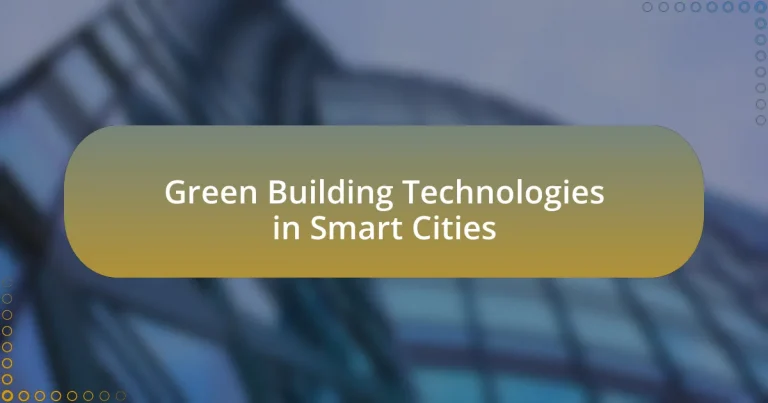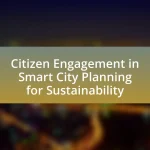Green Building Technologies in Smart Cities encompass sustainable construction practices and innovative materials aimed at enhancing energy efficiency, reducing environmental impact, and improving urban living quality. These technologies include renewable energy sources, energy-efficient systems, and sustainable materials, which collectively contribute to urban sustainability by lowering greenhouse gas emissions and resource consumption. The article outlines key principles of sustainable building design, the role of smart technologies, and the economic benefits of green buildings, while also addressing challenges and best practices for implementation in urban planning. Additionally, it highlights the importance of community engagement and metrics for measuring success in green building initiatives.
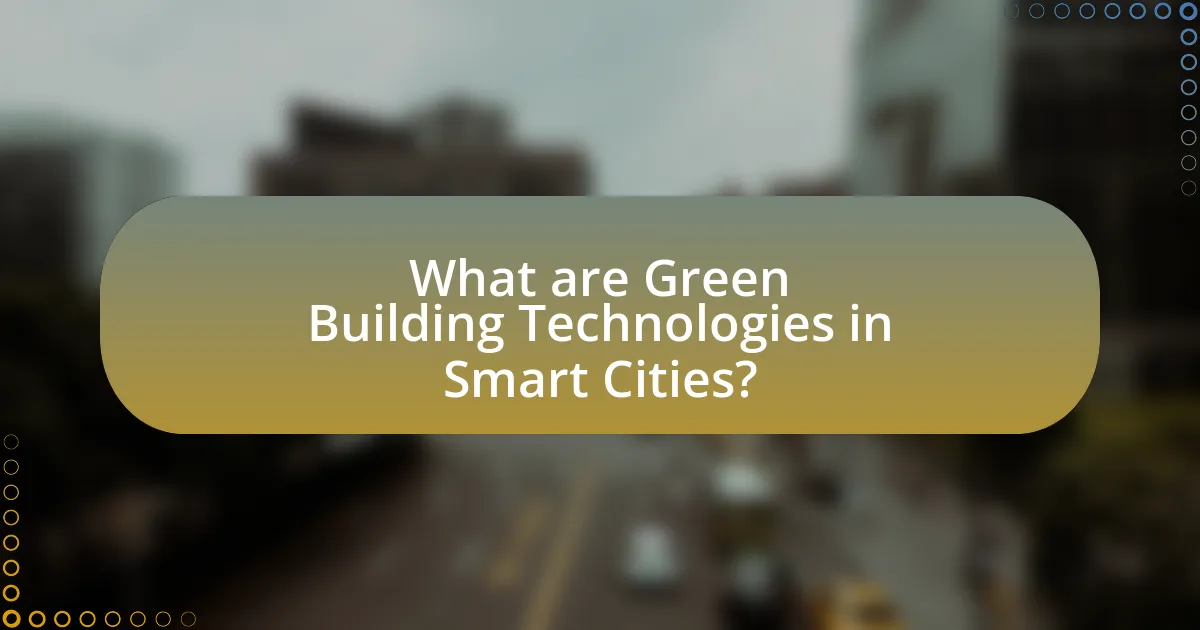
What are Green Building Technologies in Smart Cities?
Green building technologies in smart cities refer to sustainable construction practices and innovative materials that enhance energy efficiency, reduce environmental impact, and improve the quality of life for residents. These technologies include the use of renewable energy sources, such as solar panels and wind turbines, energy-efficient HVAC systems, smart building management systems, and sustainable materials like recycled steel and low-VOC paints. According to the U.S. Green Building Council, buildings that incorporate these technologies can reduce energy consumption by up to 30% and water usage by 20%, contributing to the overall sustainability goals of smart cities.
How do Green Building Technologies contribute to urban sustainability?
Green Building Technologies contribute to urban sustainability by enhancing energy efficiency, reducing waste, and promoting the use of renewable resources in urban environments. These technologies, such as energy-efficient HVAC systems, solar panels, and sustainable materials, significantly lower greenhouse gas emissions and energy consumption in buildings. For instance, the U.S. Green Building Council reports that LEED-certified buildings use 25% less energy and 11% less water than conventional buildings, demonstrating a clear impact on resource conservation. Additionally, green roofs and permeable pavements improve stormwater management, reducing urban flooding and enhancing biodiversity. Thus, the integration of Green Building Technologies is essential for creating sustainable urban spaces that minimize environmental impact and improve quality of life.
What are the key principles of sustainable building design?
The key principles of sustainable building design include energy efficiency, resource conservation, indoor environmental quality, and sustainable site development. Energy efficiency focuses on minimizing energy consumption through design strategies such as passive solar heating and high-performance insulation. Resource conservation emphasizes the use of sustainable materials and minimizing waste during construction and operation. Indoor environmental quality ensures that buildings provide healthy and comfortable spaces through proper ventilation, natural lighting, and non-toxic materials. Sustainable site development involves selecting locations that reduce environmental impact, promote biodiversity, and enhance community connectivity. These principles are supported by various studies, including the U.S. Green Building Council’s LEED certification guidelines, which provide a framework for assessing building sustainability.
How do these technologies reduce environmental impact?
Green building technologies in smart cities reduce environmental impact by enhancing energy efficiency, minimizing waste, and promoting sustainable resource use. These technologies, such as advanced insulation, energy-efficient HVAC systems, and smart lighting, significantly lower energy consumption, which can reduce greenhouse gas emissions by up to 30% according to the U.S. Green Building Council. Additionally, the use of sustainable materials and waste management systems in construction minimizes landfill contributions and promotes recycling, further decreasing environmental degradation. Furthermore, smart water management technologies can reduce water usage by 20-50%, contributing to the conservation of this vital resource.
What role do smart technologies play in green buildings?
Smart technologies play a crucial role in enhancing the efficiency and sustainability of green buildings. These technologies, such as building automation systems, energy management software, and smart sensors, optimize energy consumption, reduce waste, and improve indoor environmental quality. For instance, a study by the U.S. Green Building Council found that buildings equipped with smart technologies can achieve energy savings of up to 30% compared to traditional buildings. Additionally, smart technologies facilitate real-time monitoring and control of building systems, allowing for proactive maintenance and improved resource management, which further contributes to the overall sustainability goals of green buildings.
How do smart systems enhance energy efficiency?
Smart systems enhance energy efficiency by utilizing advanced technologies such as IoT sensors, data analytics, and automation to optimize energy consumption in buildings. These systems monitor real-time energy usage, identify inefficiencies, and adjust operations accordingly, leading to reduced energy waste. For instance, a study by the U.S. Department of Energy found that smart building technologies can reduce energy consumption by up to 30% through automated lighting and HVAC controls. This data-driven approach not only lowers operational costs but also contributes to sustainability goals by minimizing carbon footprints.
What are examples of smart technologies used in green buildings?
Examples of smart technologies used in green buildings include building automation systems, energy management systems, and smart lighting. Building automation systems integrate various functions such as heating, ventilation, air conditioning, and security to optimize energy use and enhance occupant comfort. Energy management systems monitor and control energy consumption, allowing for real-time adjustments that reduce waste and improve efficiency. Smart lighting utilizes sensors and controls to adjust brightness based on occupancy and natural light levels, significantly lowering energy usage. These technologies collectively contribute to sustainability and efficiency in green buildings, aligning with the goals of reducing carbon footprints and enhancing resource management.
Why are Green Building Technologies important for smart cities?
Green Building Technologies are important for smart cities because they enhance sustainability, reduce energy consumption, and improve the quality of urban living. These technologies, such as energy-efficient systems, sustainable materials, and smart resource management, contribute to lower greenhouse gas emissions and promote environmental stewardship. For instance, buildings designed with green technologies can reduce energy use by up to 30% compared to conventional structures, as reported by the U.S. Green Building Council. This reduction not only helps in combating climate change but also leads to cost savings for residents and municipalities. Furthermore, green buildings often incorporate features that improve indoor air quality and provide better natural lighting, which positively impacts the health and well-being of occupants.
How do they improve the quality of life for urban residents?
Green building technologies improve the quality of life for urban residents by enhancing energy efficiency, reducing environmental impact, and promoting healthier living conditions. These technologies, such as solar panels, green roofs, and energy-efficient appliances, lower utility costs and decrease greenhouse gas emissions, contributing to a more sustainable urban environment. For instance, buildings designed with green technologies can reduce energy consumption by up to 30%, as reported by the U.S. Green Building Council. Additionally, the incorporation of natural elements and improved air quality in green buildings has been linked to better physical and mental health outcomes for residents, as evidenced by studies showing reduced respiratory issues and increased productivity in green-certified spaces.
What economic benefits do they provide to cities?
Green building technologies provide significant economic benefits to cities by reducing energy costs, increasing property values, and creating jobs. These technologies, such as energy-efficient systems and sustainable materials, lower utility expenses for both residential and commercial buildings, leading to savings that can be reinvested into the local economy. For instance, the U.S. Green Building Council reports that green buildings can reduce energy consumption by up to 30%, translating into substantial cost reductions. Additionally, properties built with green technologies often see higher market values; a study by the National Association of Realtors found that green homes sell for an average of 9% more than traditional homes. Furthermore, the implementation of green building practices stimulates job creation in construction, manufacturing, and maintenance sectors, contributing to economic growth. According to the U.S. Bureau of Labor Statistics, jobs in the green building sector are projected to grow significantly, enhancing local employment opportunities.
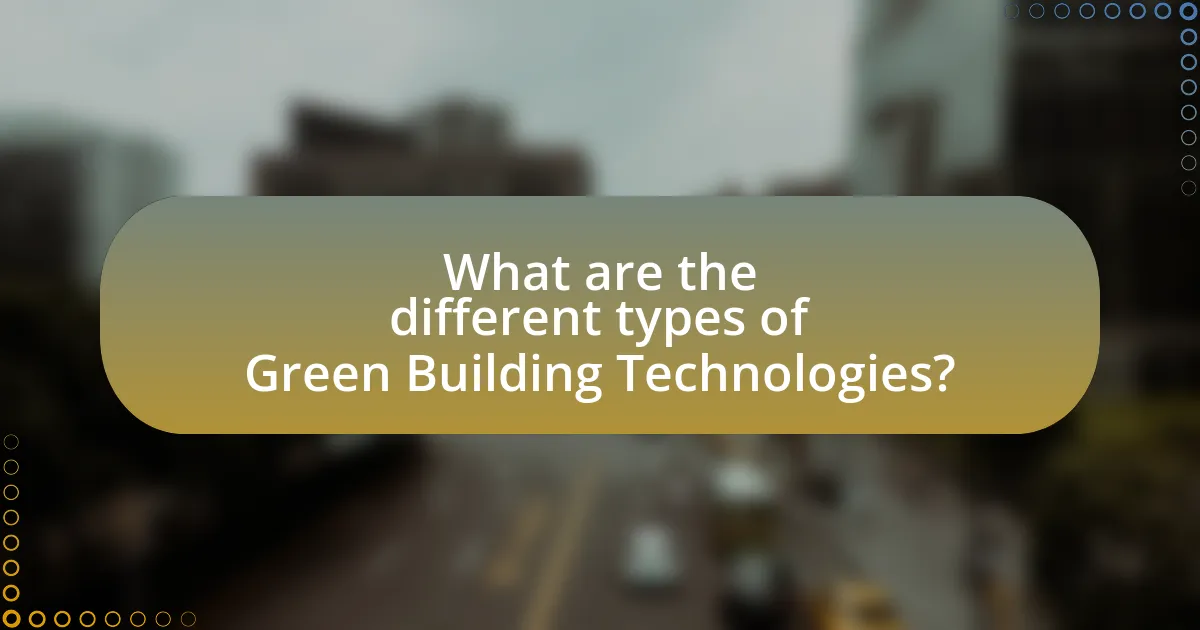
What are the different types of Green Building Technologies?
The different types of Green Building Technologies include energy-efficient systems, sustainable materials, water conservation technologies, and renewable energy solutions. Energy-efficient systems, such as advanced HVAC and lighting controls, reduce energy consumption significantly; for instance, buildings utilizing LED lighting can save up to 75% in energy costs compared to traditional lighting. Sustainable materials, like recycled steel and bamboo, minimize environmental impact by reducing resource extraction and waste. Water conservation technologies, including rainwater harvesting and low-flow fixtures, can decrease water usage by up to 50%. Renewable energy solutions, such as solar panels and wind turbines, enable buildings to generate their own energy, contributing to a reduction in greenhouse gas emissions. These technologies collectively enhance the sustainability and efficiency of buildings in smart cities.
What renewable energy sources are commonly integrated into green buildings?
Common renewable energy sources integrated into green buildings include solar energy, wind energy, geothermal energy, and biomass. Solar energy is often harnessed through photovoltaic panels or solar thermal systems, providing electricity and heating. Wind energy can be utilized through small-scale wind turbines, contributing to the building’s energy supply. Geothermal energy systems leverage the Earth’s stable temperatures for heating and cooling, enhancing energy efficiency. Biomass energy, derived from organic materials, can be used for heating and electricity generation. These sources collectively reduce reliance on fossil fuels and lower greenhouse gas emissions, aligning with sustainable building practices.
How do solar panels contribute to energy efficiency?
Solar panels contribute to energy efficiency by converting sunlight into electricity, which reduces reliance on fossil fuels and lowers energy consumption from non-renewable sources. This conversion process allows buildings to generate their own power, leading to decreased energy costs and reduced greenhouse gas emissions. According to the U.S. Department of Energy, solar energy systems can reduce electricity bills by 50% or more, demonstrating their significant impact on energy efficiency in urban environments.
What is the role of wind energy in urban settings?
Wind energy plays a crucial role in urban settings by providing a renewable source of electricity that can reduce reliance on fossil fuels. Urban areas can harness wind energy through the installation of small-scale wind turbines, which can generate power for local buildings and infrastructure. According to the U.S. Department of Energy, urban wind energy systems can contribute to energy resilience, lower energy costs, and decrease greenhouse gas emissions. Additionally, integrating wind energy into urban planning supports the goals of smart cities by promoting sustainable development and enhancing energy efficiency.
What sustainable materials are used in green building construction?
Sustainable materials used in green building construction include bamboo, recycled steel, reclaimed wood, and straw bales. Bamboo is a rapidly renewable resource that grows quickly and absorbs carbon dioxide, making it an eco-friendly choice. Recycled steel reduces the need for new metal production, conserving energy and resources. Reclaimed wood repurposes existing materials, minimizing waste and preserving forests. Straw bales provide excellent insulation and are a byproduct of agricultural processes, promoting sustainability in construction. These materials contribute to reducing the environmental impact of buildings while enhancing energy efficiency and resource conservation.
How do recycled materials impact the building process?
Recycled materials significantly enhance the building process by reducing waste and lowering resource consumption. The incorporation of materials such as reclaimed wood, recycled steel, and repurposed concrete minimizes the demand for new raw materials, which in turn decreases energy usage and greenhouse gas emissions associated with extraction and processing. For instance, using recycled steel can save up to 75% of the energy required to produce new steel, according to the American Iron and Steel Institute. Additionally, utilizing recycled materials can lead to cost savings in construction, as they often come at a lower price point compared to virgin materials. This practice not only supports sustainable building practices but also aligns with the goals of green building technologies in smart cities, promoting environmental responsibility and resource efficiency.
What are the benefits of using locally sourced materials?
Using locally sourced materials reduces environmental impact and supports local economies. By minimizing transportation distances, these materials lower carbon emissions associated with shipping, contributing to sustainability goals in green building. Additionally, utilizing local resources fosters community engagement and economic resilience, as it keeps financial resources within the local area. Studies indicate that local sourcing can decrease construction costs by up to 20% due to reduced logistics expenses, further enhancing the economic viability of green building projects in smart cities.
What innovative design strategies are employed in green buildings?
Innovative design strategies employed in green buildings include passive solar design, energy-efficient systems, and sustainable materials. Passive solar design utilizes building orientation and window placement to maximize natural light and heat, reducing reliance on artificial lighting and heating. Energy-efficient systems, such as high-performance HVAC and smart building technologies, optimize energy use and minimize waste. Sustainable materials, including recycled and locally sourced products, reduce environmental impact and promote resource conservation. These strategies collectively contribute to lower energy consumption and a reduced carbon footprint, aligning with the goals of sustainable urban development.
How does passive design optimize energy use?
Passive design optimizes energy use by utilizing natural resources for heating, cooling, and lighting, thereby reducing reliance on mechanical systems. This approach incorporates strategies such as maximizing natural light through window placement, enhancing thermal mass to regulate indoor temperatures, and utilizing proper insulation to minimize heat loss. Research indicates that buildings designed with passive strategies can achieve energy savings of up to 50% compared to conventional designs, as demonstrated in studies like the “Passive House Standard” which shows significant reductions in energy consumption while maintaining comfort levels.
What is the significance of green roofs and walls?
Green roofs and walls are significant for their ability to enhance urban sustainability and improve environmental quality. They provide insulation, reduce energy consumption, and mitigate urban heat island effects by lowering surrounding temperatures. Studies indicate that green roofs can reduce energy use for heating and cooling by up to 75%, while also managing stormwater runoff by absorbing rainwater, thus decreasing the burden on urban drainage systems. Additionally, they contribute to biodiversity by creating habitats for various species, promoting ecological balance in urban settings.
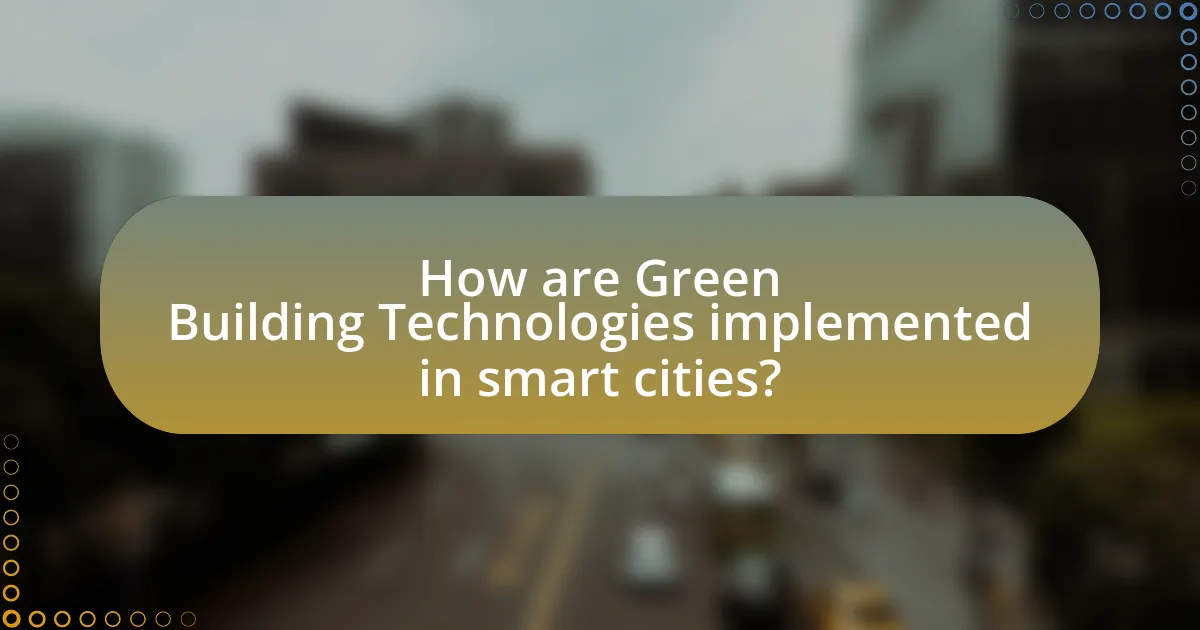
How are Green Building Technologies implemented in smart cities?
Green Building Technologies are implemented in smart cities through the integration of sustainable design principles, energy-efficient systems, and advanced materials. Smart cities utilize technologies such as Building Information Modeling (BIM) for efficient planning and management, which enhances resource efficiency and reduces waste. Additionally, renewable energy sources like solar panels and wind turbines are incorporated into building designs to minimize carbon footprints. According to the World Green Building Council, buildings account for 39% of global carbon emissions, highlighting the importance of these technologies in reducing environmental impact. Furthermore, smart cities often employ IoT devices to monitor energy consumption and optimize building performance in real-time, ensuring that energy use is minimized and sustainability goals are met.
What are the steps for integrating green technologies into urban planning?
The steps for integrating green technologies into urban planning include assessing current urban infrastructure, engaging stakeholders, establishing sustainability goals, selecting appropriate green technologies, and implementing policies for integration.
First, assessing current urban infrastructure involves evaluating existing systems to identify areas for improvement and potential for green technology application. Engaging stakeholders, including community members, government agencies, and private sector partners, ensures that diverse perspectives are considered in the planning process. Establishing sustainability goals provides a clear framework for what the integration aims to achieve, such as reducing carbon emissions or enhancing energy efficiency.
Selecting appropriate green technologies, such as renewable energy sources, green roofs, or sustainable transportation options, is crucial for meeting the established goals. Finally, implementing policies for integration, including zoning regulations and incentives for green building practices, facilitates the adoption of these technologies in urban development projects.
These steps are supported by various case studies, such as the integration of solar panels in San Diego’s urban planning, which resulted in a significant increase in renewable energy usage and a reduction in greenhouse gas emissions.
How do city policies support green building initiatives?
City policies support green building initiatives by implementing regulations and incentives that promote sustainable construction practices. For instance, many cities adopt building codes that require energy-efficient designs and materials, which directly contribute to reducing carbon footprints. Additionally, financial incentives such as tax credits, grants, or rebates for developers who incorporate green technologies further encourage the adoption of environmentally friendly practices. According to the U.S. Green Building Council, cities that have enacted such policies often see a significant increase in the number of certified green buildings, demonstrating the effectiveness of these regulations in fostering sustainable urban development.
What role do public-private partnerships play in implementation?
Public-private partnerships (PPPs) play a crucial role in the implementation of green building technologies in smart cities by facilitating collaboration between government entities and private sector stakeholders. These partnerships leverage the strengths of both sectors, where public entities provide regulatory support and funding, while private companies contribute innovation, expertise, and efficiency in project execution. For instance, a study by the World Economic Forum highlights that PPPs can accelerate the deployment of sustainable infrastructure by sharing risks and resources, ultimately leading to more effective and timely implementation of green technologies.
What challenges do cities face in adopting Green Building Technologies?
Cities face several challenges in adopting Green Building Technologies, primarily including high initial costs, lack of skilled labor, and regulatory barriers. High initial costs deter investment, as many green technologies require significant upfront capital, which can be a barrier for municipalities with limited budgets. Additionally, the shortage of skilled labor trained in green building practices hampers the effective implementation of these technologies. Regulatory barriers, such as outdated building codes and zoning laws, can also impede the adoption of innovative green solutions, as they may not accommodate new sustainable practices. These challenges collectively hinder the transition to more sustainable urban environments.
How can financial barriers be overcome?
Financial barriers can be overcome through targeted funding mechanisms, public-private partnerships, and government incentives. For instance, cities can implement grant programs or low-interest loans specifically for green building projects, which can alleviate upfront costs. Research from the International Energy Agency indicates that financial incentives can significantly increase the adoption of energy-efficient technologies, demonstrating that strategic financial support can effectively reduce barriers. Additionally, collaboration between private developers and public entities can lead to innovative financing solutions, such as green bonds, which have been successfully utilized in various smart city initiatives to fund sustainable infrastructure.
What are the common regulatory hurdles?
Common regulatory hurdles in green building technologies within smart cities include stringent zoning laws, complex permitting processes, and compliance with building codes that may not accommodate innovative designs. Zoning laws often restrict the types of materials and technologies that can be used, while permitting processes can be lengthy and bureaucratic, delaying project timelines. Additionally, building codes may not reflect the latest advancements in sustainable technologies, creating barriers for developers seeking to implement energy-efficient systems. These challenges can hinder the adoption of green building practices, as evidenced by studies indicating that regulatory constraints are a significant factor in the slow uptake of sustainable construction methods.
What best practices can cities adopt for successful implementation?
Cities can adopt several best practices for the successful implementation of green building technologies, including establishing clear policies, engaging stakeholders, and investing in training. Clear policies, such as building codes that prioritize sustainability, provide a framework for developers and builders to follow. Engaging stakeholders, including community members and industry experts, ensures that diverse perspectives are considered, leading to more effective solutions. Investing in training programs for construction workers and architects on green technologies enhances the skill set necessary for implementation. These practices have been shown to improve project outcomes and increase the adoption of sustainable building practices, as evidenced by cities like San Francisco, which has successfully integrated green building standards into its development processes.
How can community engagement enhance green building projects?
Community engagement enhances green building projects by fostering collaboration between stakeholders, which leads to more sustainable and accepted designs. Engaging the community allows for the incorporation of local knowledge and preferences, ensuring that the buildings meet the specific needs of the residents. Research indicates that projects with high community involvement often experience increased support and reduced opposition, as seen in the case of the Green Building Council’s initiatives, which reported a 30% increase in project approval rates when community input was actively sought. This collaborative approach not only improves the environmental performance of buildings but also strengthens community ties and promotes a sense of ownership among residents.
What metrics should be used to measure success in green building initiatives?
Key metrics to measure success in green building initiatives include energy efficiency, water usage, indoor air quality, and material sustainability. Energy efficiency can be quantified through metrics such as Energy Use Intensity (EUI), which measures energy consumption per square foot, and can show reductions in energy costs and carbon emissions. Water usage is assessed through metrics like water consumption per occupant or per square foot, highlighting conservation efforts. Indoor air quality is evaluated using metrics such as Volatile Organic Compounds (VOCs) levels and CO2 concentrations, which are critical for occupant health and comfort. Material sustainability is measured by the percentage of recycled or sustainably sourced materials used in construction, reflecting the initiative’s environmental impact. These metrics collectively provide a comprehensive view of a green building’s performance and its contribution to sustainability goals.
What are practical tips for promoting Green Building Technologies in smart cities?
Practical tips for promoting Green Building Technologies in smart cities include implementing incentives for developers to adopt sustainable practices, such as tax breaks or grants for energy-efficient building designs. Additionally, cities can establish clear regulations and standards that mandate the use of green technologies in new construction and renovations. Public awareness campaigns can educate citizens on the benefits of green buildings, fostering community support. Collaborating with technology providers to integrate smart systems that monitor energy usage can also enhance the effectiveness of green technologies. Evidence shows that cities with supportive policies see a higher adoption rate of sustainable practices, leading to reduced carbon footprints and improved urban living conditions.
